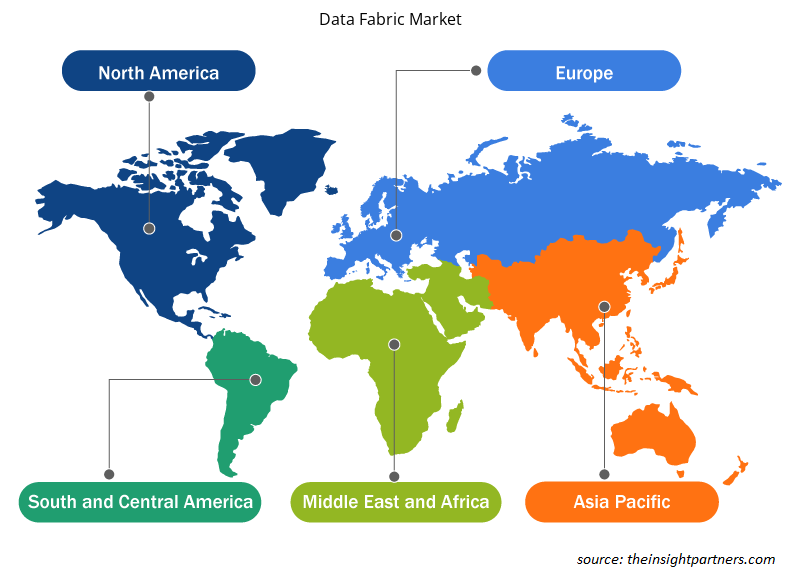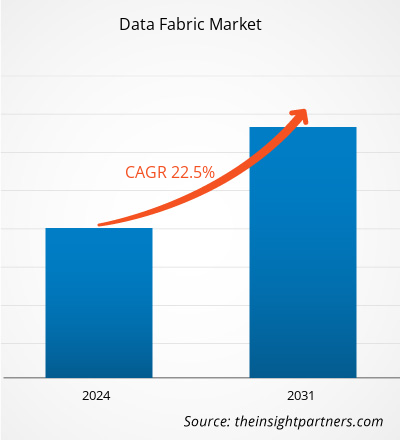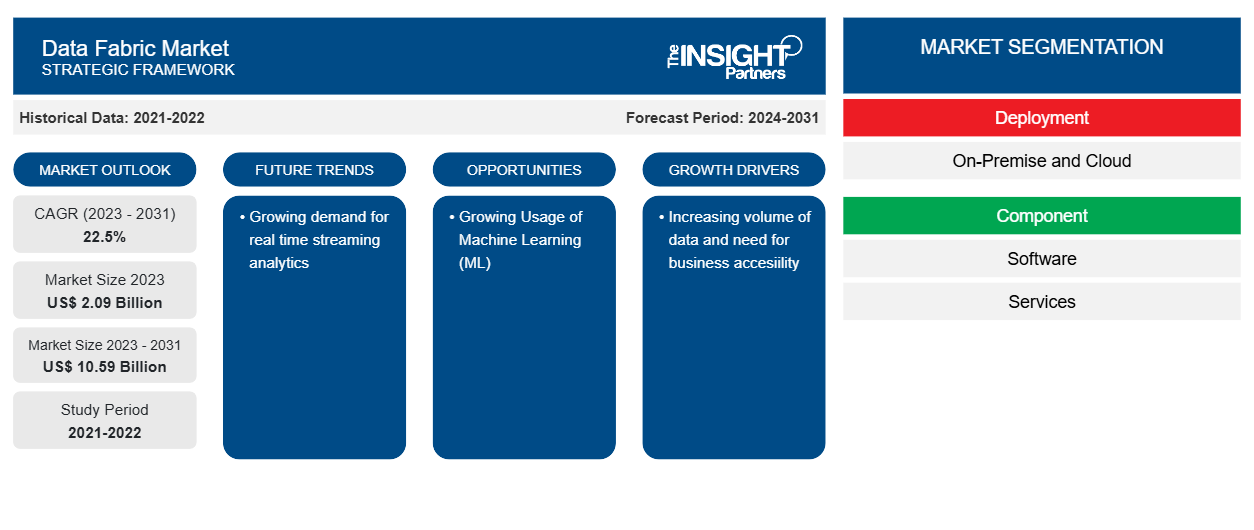من المتوقع أن ينمو سوق نسيج البيانات من 2.09 مليار دولار أمريكي في عام 2023 إلى 10.59 مليار دولار أمريكي بحلول عام 2031؛ ومن المتوقع أن يتوسع بمعدل نمو سنوي مركب قدره 22.5٪ من عام 2023 إلى عام 2031. ومن المتوقع أن يكون الطلب المتزايد على تحليلات البث في الوقت الفعلي اتجاهًا رئيسيًا في السوق.
تحليل سوق نسيج البيانات
يوفر نسيج البيانات إمكانية تخزين البيانات بشكل افتراضي، مما يسمح للمؤسسات بتنفيذ وصول سلس إلى البيانات مع جعلها في متناول الجميع. مع تنفيذ نسيج البيانات، يمكن لمستخدمي الأعمال الوصول إلى البيانات بأقل قدر من مشاركة تكنولوجيا المعلومات، مما يؤدي إلى بيئة أسرع وأسهل للوصول إلى البيانات وتبادلها. يعمل نسيج البيانات المنطقي المصمم جيدًا على توحيد الأمن الأساسي وإدارة البيانات. وبالتالي، من المتوقع أن ينمو سوق نسيج البيانات خلال فترة التنبؤ.
نظرة عامة على صناعة سوق نسيج البيانات
Data Fabric هو نظام شامل لدمج وإدارة البيانات يتضمن بنية وأدوات لإدارة البيانات ودمجها وبيانات مشتركة لمساعدة المؤسسات في إدارة بياناتها. يوفر Data Fabric تجربة مستخدم واحدة ومتسقة وإمكانية الوصول إلى البيانات في الوقت الفعلي لكل عضو في الشبكة العالمية للمؤسسة. يهدف Data Fabric إلى مساعدة المؤسسات في حل مشكلات البيانات المعقدة وحالات الاستخدام من خلال إدارة البيانات عبر مجموعة متنوعة من التطبيقات والمنصات والمواقع. يوفر Data Fabric وصولاً سلسًا ومشاركة للبيانات في بيئة بيانات متفرقة.
قم بتخصيص هذا التقرير ليناسب متطلباتك
ستحصل على تخصيص لأي تقرير - مجانًا - بما في ذلك أجزاء من هذا التقرير، أو تحليل على مستوى الدولة، وحزمة بيانات Excel، بالإضافة إلى الاستفادة من العروض والخصومات الرائعة للشركات الناشئة والجامعات
- احصل على أهم اتجاهات السوق الرئيسية لهذا التقرير.ستتضمن هذه العينة المجانية تحليلاً للبيانات، بدءًا من اتجاهات السوق وحتى التقديرات والتوقعات.
محركات وفرص سوق نسيج البيانات
زيادة حجم البيانات لصالح نمو السوق
تتطلب أي منظمة تركز على البيانات نهجًا شاملاً يتناول الوقت والمكان وأنواع البرامج المختلفة ومواقع البيانات. يجب أن تكون البيانات متاحة لمن يحتاجون إليها بدلاً من إخفائها خلف جدران الحماية أو توزيعها عبر أماكن متعددة. تتطلب الشركات حل بيانات آمن وفعال ومتسق ومستقبلي لتحسين كفاءتها التشغيلية. وبالتالي، من المتوقع أن ينمو الطلب على بنية البيانات خلال فترة التنبؤ.
الاستخدام المتزايد للتعلم الآلي (ML)
قد تراقب خوارزميات التعلم الآلي خطوط أنابيب البيانات وتقترح الروابط والتكاملات ذات الصلة . تستخرج هذه الخوارزميات المعلومات من البيانات لأنها مرتبطة بهيكل البيانات، وتراجع جميع بيانات الأعمال، وتجد الروابط والارتباطات ذات الصلة. يعد توفير البيانات أحد أكثر جوانب تدريب نموذج التعلم الآلي استهلاكًا للوقت. يجعل تصميم Data Fabric نماذج التعلم الآلي أكثر كفاءة من خلال تقليل وقت إعداد البيانات. كما أنه يحسن قابلية استخدام البيانات المعدة في تطبيقات ونماذج مختلفة. توزع الشركات البيانات محليًا وفي السحابة وفي إنترنت الأشياء . يتيح هيكل البيانات الوصول المقيد إلى البيانات الآمنة ويعزز عمليات التعلم الآلي. وبالتالي، من المتوقع أن يؤدي تطبيق التعلم الآلي في بنية البيانات إلى تغذية نمو السوق خلال فترة التنبؤ.
نسيج البيانات
تحليل تجزئة تقرير السوق
تتمثل القطاعات الرئيسية التي ساهمت في اشتقاق تحليل سوق Data Fabric في التغطية حسب النشر والمكون والحل والمستخدم النهائي.
- من حيث النشر، ينقسم السوق إلى محلي وسحابي. وقد تصدر قطاع السحابة السوق في عام 2023.
- بناءً على المكونات، يتم تقسيم السوق إلى برمجيات وخدمات
- بناءً على الحل، يتم تقسيم السوق إلى اكتشاف البيانات، واستيعاب البيانات، وتنظيم البيانات، والوصول إلى بيانات النسيج، وإدارة البيانات، وإدارة النسيج و
- على أساس المستخدمين النهائيين، يتم تقسيم السوق إلى BFSI، وتكنولوجيا المعلومات والاتصالات، والتجزئة، والرعاية الصحية والأدوية ، وغيرها
تحليل حصة سوق نسيج البيانات حسب المنطقة الجغرافية
على أساس المنطقة، يتم تقسيم السوق إلى أمريكا الشمالية وأوروبا ومنطقة آسيا والمحيط الهادئ والشرق الأوسط وأفريقيا وأمريكا الجنوبية والوسطى.
استحوذت منطقة أمريكا الشمالية على حصة بارزة من سوق نسيج البيانات في عام 2023 ومن المتوقع أن تنمو بمعدل نمو سنوي مركب كبير خلال الفترة المتوقعة. قد يُعزى هذا النمو إلى وجود العديد من رواد السوق والتبني المبكر للتبني التكنولوجي. علاوة على ذلك، من المتوقع أن تنمو منطقة آسيا والمحيط الهادئ بأسرع معدل نمو سنوي مركب خلال الفترة المتوقعة. قد يُعزى هذا النمو إلى العدد المتزايد من مراكز البيانات والرقمنة المتزايدة.
رؤى إقليمية حول سوق نسيج البيانات
لقد قام المحللون في Insight Partners بشرح الاتجاهات والعوامل الإقليمية المؤثرة على سوق Data Fabric طوال فترة التوقعات بشكل شامل. يناقش هذا القسم أيضًا قطاعات سوق Data Fabric والجغرافيا في جميع أنحاء أمريكا الشمالية وأوروبا ومنطقة آسيا والمحيط الهادئ والشرق الأوسط وأفريقيا وأمريكا الجنوبية والوسطى.

- احصل على بيانات إقليمية محددة لسوق نسيج البيانات
نطاق تقرير سوق نسيج البيانات
| سمة التقرير | تفاصيل |
|---|---|
| حجم السوق في عام 2023 | 2.09 مليار دولار أمريكي |
| حجم السوق بحلول عام 2031 | 10.59 مليار دولار أمريكي |
| معدل النمو السنوي المركب العالمي (2023 - 2031) | 22.5% |
| البيانات التاريخية | 2021-2022 |
| فترة التنبؤ | 2024-2031 |
| القطاعات المغطاة | حسب النشر
|
| المناطق والدول المغطاة | أمريكا الشمالية
|
| قادة السوق وملفات تعريف الشركات الرئيسية |
|
كثافة اللاعبين في السوق: فهم تأثيرها على ديناميكيات الأعمال
يشهد سوق Data Fabric نموًا سريعًا، مدفوعًا بالطلب المتزايد من المستخدم النهائي بسبب عوامل مثل تفضيلات المستهلك المتطورة والتقدم التكنولوجي والوعي المتزايد بفوائد المنتج. ومع ارتفاع الطلب، تعمل الشركات على توسيع عروضها والابتكار لتلبية احتياجات المستهلكين والاستفادة من الاتجاهات الناشئة، مما يؤدي إلى زيادة نمو السوق.
تشير كثافة اللاعبين في السوق إلى توزيع الشركات أو المؤسسات العاملة في سوق أو صناعة معينة. وهي تشير إلى عدد المنافسين (اللاعبين في السوق) الموجودين في مساحة سوق معينة نسبة إلى حجمها أو قيمتها السوقية الإجمالية.
الشركات الرئيسية العاملة في سوق نسيج البيانات هي:
- دينودو للتكنولوجيا
- شركة آي بي إم
- شركة إنفورماتيكا
- كيه 2 فيو
- شركة نت آب
- شركة أوراكل
إخلاء المسؤولية : الشركات المذكورة أعلاه ليست مرتبة بأي ترتيب معين.

- احصل على نظرة عامة على أهم اللاعبين الرئيسيين في سوق Data Fabric
أخبار سوق Data Fabric والتطورات الأخيرة
يتم تقييم سوق Data Fabric من خلال جمع البيانات النوعية والكمية بعد البحث الأولي والثانوي، والذي يتضمن منشورات الشركات المهمة وبيانات الجمعيات وقواعد البيانات. فيما يلي بعض التطورات في سوق Data Fabric:
- تُحدث شركة LigaData، وهي شركة رائدة في مجال تكنولوجيا الاتصالات، ثورة في صناعة تحليلات بيانات الاتصالات بإطلاقها منتجها الجديد LigaData Telecom Data Fabric 4.0 وتطبيقات LigaData Telecom AI. وتمكّن هذه المنتجات الجديدة شركات الاتصالات ومقدمي خدمات الاتصالات في مبادراتهم من تحويل أعمالهم من شركات اتصالات تقليدية إلى شركات تقنية سريعة تعتمد على البيانات والذكاء الاصطناعي مع دفع نمو الإيرادات والاحتفاظ بحصة السوق وتحسين تجربة العملاء. (المصدر: LigaData، بيان صحفي، فبراير 2024)
تقرير سوق نسيج البيانات والتغطية والنتائج النهائية
يتم تقدير توقعات سوق Data Fabric بناءً على نتائج بحثية ثانوية وأولية مختلفة، مثل منشورات الشركات الرئيسية وبيانات الجمعيات وقواعد البيانات. يوفر تقرير السوق "حجم سوق Data Fabric والتوقعات (2021-2031)" تحليلاً مفصلاً للسوق يغطي المجالات التالية-
- حجم سوق نسيج البيانات وتوقعاته على المستويات العالمية والإقليمية والوطنية لجميع قطاعات السوق الرئيسية التي يغطيها النطاق
- اتجاهات سوق Data Fabric، بالإضافة إلى ديناميكيات السوق مثل المحركات والقيود والفرص الرئيسية
- تحليل مفصل لقوى PEST/Porter الخمس وSWOT
- تحليل سوق Data Fabric الذي يغطي اتجاهات السوق الرئيسية والإطار العالمي والإقليمي والجهات الفاعلة الرئيسية واللوائح والتطورات الأخيرة في السوق
- تحليل المشهد الصناعي والمنافسة الذي يغطي تركيز السوق، وتحليل خريطة الحرارة، واللاعبين البارزين، والتطورات الأخيرة في سوق Data Fabric
- ملفات تعريفية مفصلة للشركة.
- التحليل التاريخي (سنتان)، سنة الأساس، التوقعات (7 سنوات) مع معدل النمو السنوي المركب
- تحليل PEST و SWOT
- حجم السوق والقيمة / الحجم - عالمي، إقليمي، بلد
- الصناعة والمنافسة
- مجموعة بيانات إكسل
التقارير الحديثة
تقارير ذات صلة
شهادات العملاء
سبب الشراء
- اتخاذ قرارات مدروسة
- فهم ديناميكيات السوق
- تحليل المنافسة
- رؤى العملاء
- توقعات السوق
- تخفيف المخاطر
- التخطيط الاستراتيجي
- مبررات الاستثمار
- تحديد الأسواق الناشئة
- تحسين استراتيجيات التسويق
- تعزيز الكفاءة التشغيلية
- مواكبة التوجهات التنظيمية





















 احصل على عينة مجانية ل - سوق نسيج البيانات
احصل على عينة مجانية ل - سوق نسيج البيانات